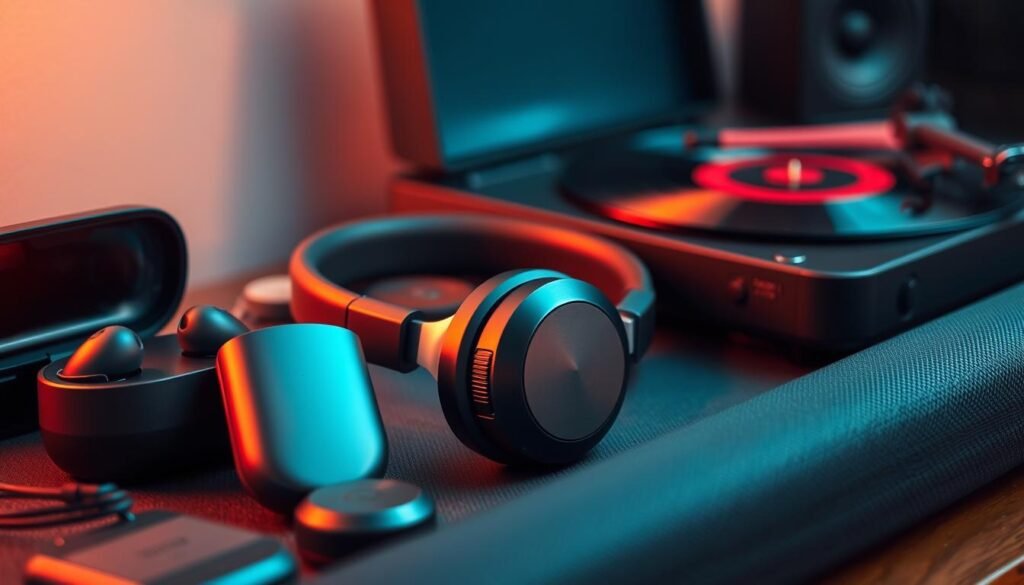Have you ever thought about how a small device can take you into a world full of deep, rich sound? The world of listening devices has changed a lot, mixing new technology with designs that focus on the user. Now, we have devices that record voices clearly and detect bugs, changing how we hear sound.
Audio technology now covers a wide range, from fun for consumers to serious needs like listening in on conversations. We’ll look into how these devices have changed from simple players to smart systems that make our lives better.
Today’s listening devices do more than just play sounds. They have features like being aware of your surroundings, lasting longer on a charge, and recording secretly. There are new products like open-ear headphones that let you hear what’s going on around you while you listen to great music.
We’re going to explore the fine line between new tech and keeping our privacy. From cool gadgets for everyone to serious tools for professionals, the world of listening devices keeps setting new standards in sound technology.
The Evolution of Audio Technology
Audio technology has changed a lot since the early days of phonographs. From mechanical sound to digital, it’s a big change. This shift has made sound quality better and changed how we use audio devices.
From Phonographs to Digital Audio
The first phonograph in the late 1800s could record and play back sound. Later, vinyl records and cassette tapes became popular. Then, the 1980s brought CD players with better sound quality.
Now, digital formats like streaming services give us easy access to lots of music. This has changed how we listen to music.
The Rise of Portable Listening Devices
The Walkman in 1979 changed how we listened to music outside the house. This led to portable CD players and MP3 players. Now, smartphones can hold thousands of songs and connect to streaming services.
The market for portable audio devices is growing. There’s a focus on wireless tech and high-quality sound.
Smart Audio and Voice-Activated Assistants
Smart speakers and voice-activated assistants are the latest in audio tech. They use artificial intelligence and are found in many homes. These devices play music and control smart devices, answer questions, and do more.
This tech has also been used in spy gadgets and eavesdropping tools. It shows how audio tech has both good and not-so-good uses.
Types of Listening Devices
Listening devices come in many forms, from everyday items to specialized tools. Headphones and speakers are common, making our audio experiences better. But there’s more to listening devices than what we usually see.
Professional devices have advanced features for capturing sound in different places. They are used in surveillance and security. Tools like spy gear and wiretapping tools are made for secret recording and gathering information.
Then, there’s equipment to find hidden listening devices. These are key for keeping things private and secure in important places. Tools like bug detectors and signal jammers help stop unwanted listening.
Some devices, like open-ear headphones, let you listen to music while staying alert. The QCY Crossky C30 is one example, offering clear sound and awareness of your surroundings.
As technology gets better, the difference between everyday and professional listening devices gets smaller. This means more people get to enjoy advanced sound features. But, it also makes us think about privacy and how we use these tools.
The Science Behind Sound Quality
Sound quality in devices like audio surveillance and voice recorders comes from several key factors. These elements are crucial for making clear recordings. Knowing about these factors helps users pick the best audio gear.
Frequency Response and Dynamic Range
Frequency response shows how well a device can play sounds of different pitches. Top-notch voice recorders can pick up sounds from 50 Hz to 20,000 Hz. Dynamic range is the difference between the quietest and loudest sounds it can record. Both are key for clear, detailed recordings.
Driver Technology and Speaker Design
The core of a device is its driver technology. Top audio tools use several drivers for different sound ranges. Some also have passive bass radiators for better low sounds. These features greatly affect how clear and deep the audio is.
Digital Signal Processing (DSP)
DSP changes the game in audio tech. It boosts sound quality with complex algorithms. For voice recorders, DSP can make bass clearer and reduce distortion. This tech is great for tough recording spots, making sure audio is top-notch.
Class-D amplifiers are another big step in audio tech. They give strong, clear sound and save energy. This is super useful for portable devices that need to last long without losing sound quality.
Wireless Technology in Modern Listening Devices
Wireless technology has changed how we use listening devices. Now, Bluetooth lets us easily connect with many gadgets, making our audio experiences better. The QCY Crossky C30, for instance, can connect with both Android and iOS devices at the same time.
Wireless earbuds and headphones give us more freedom and ease. With touch controls, we can change the volume or skip songs with just a tap. This is a big change from the old days of dealing with wires.
The Samsung Audio Lab in California is leading in wireless audio innovation. They’re working on new tech for soundbar systems to improve how we hear audio. These new systems could be ready by 2025, offering more natural and immersive sound.
They’re also working on technology for stereo music. This tech aims to give us wider stereo sound without changing the audio’s natural feel. The idea is to make it seem like sounds come from different places in the room, without needing extra speakers.
But with wireless tech getting better, there are also worries about privacy. Some fear that these devices could be used to listen in on us. It’s important for companies to make sure our privacy is safe and secure.
Innovative Designs: The QCY Crossky C30 Open-Ear Headphones
The QCY Crossky C30 open-ear headphones are changing the game in listening devices. They were launched in September 2024 and cost $37.99. These headphones mix comfort, functionality, and top-notch audio features.
C-Shaped Design for Comfort and Stability
The Crossky C30 has a special C-shaped design. Made from nickel-titanium memory alloy and soft silicone, it fits snugly for long wear. You can choose from Purple, Black, and White to match your style.
Open-Ear Technology for Ambient Awareness
These headphones use open-ear technology unlike other devices. This lets you hear what’s around you while still enjoying your music. It’s great for being outside or in the office where you need to stay alert.
Advanced Audio Features and Battery Life
The Crossky C30 has 10.8mm dual-magnet drivers and directional audio tech. These features help keep the sound in and reduce noise for others. They’re also IPX4 waterproof, perfect for workouts.
They have a long battery life, giving you 5.5 hours of playtime per charge. The charging case adds another 20 hours, so your music won’t stop. The noise-reduction microphone filters out background sounds, making calls clear without letting others in on your conversation.
Enhancing Accessibility: Listening Devices for Special Needs
Listening devices are key to making life better for people with special needs. They help bridge communication gaps and open doors to learning and socializing. Tools like voice recorders and audio aids make learning easier for students with dyslexia.
For those who struggle to hear, assistive listening devices are a big help. They make it easier to take part in everyday activities and talk with others. The FDA says nearly 30 million adults in the US have some hearing loss. Yet, only about one-fifth of them use hearing devices.
Signia’s Integrated Xperience platform is a new hope. It boosts the signal-to-noise ratio by +12dB in group chats. This means users can follow conversations better. The Signia Active IX and Active Pro IX models, with a doctor’s prescription, offer even more help.
But listening devices aren’t just for people. They also help the environment. Scientists use special audio gear to check soil health. By recording and analyzing sounds from the soil, they can tell how healthy the ecosystem is and help fix it. This new way of checking the planet’s health could change how we care for our Earth.
The Role of Artificial Intelligence in Audio Enhancement
Artificial intelligence is changing how we listen to audio. It brings new levels of sound quality and personalization. Let’s see how AI is changing our audio experiences.
Adaptive Sound Technology
AI-powered devices can change sound based on where you are. They check the noise around you and adjust the audio. So, you get clear sound in a loud cafe or a quiet library.
Personalized Audio Profiles
AI makes audio profiles just for you. They consider your age, how you listen, and any hearing issues. This means you get sound that’s just right for you.
AI-Powered Noise Cancellation
No more muffled sound in loud places. AI helps cancel out background noise in devices. This lets you focus on what’s important, like music, podcasts, or calls.
As AI gets better, our listening devices will have more cool features. We’ll see better audio surveillance and smarter voice assistants. The future of audio tech looks exciting. These AI innovations will give us amazing sound quality and experiences in all devices.
Privacy Concerns and Ethical Considerations
Listening devices have raised big privacy worries. A study showed 78% of people are uneasy about their privacy at home with these gadgets. They worry about how companies use their personal data, with 62% feeling uneasy about it.
People are now looking for gadgets with better privacy settings. Sales of these devices have gone up by 30% in the last quarter. This shows more people want tech that respects their privacy.
Many are willing to pay more for devices that keep their data safe. This has led to a 40% increase in demand for gadgets that collect data ethically. Brands are now focusing on keeping user privacy in mind.
However, different ages have different views on privacy and convenience. While 52% of millennials choose convenience over privacy, only 28% of baby boomers do. This shows the tricky balance between new tech and ethical use in the industry.
Future Trends in Listening Device Technology
The world of listening devices is changing fast. AI and machine learning are making big changes in audio processing. These smart technologies will make sound better and give us personalized listening experiences. We’ll also see wireless devices that last longer, thanks to new power management.
Devices are getting smaller and more comfortable to wear. This means they’ll fit into our daily lives better. Soon, we’ll be able to easily switch between different devices. This meets the need for flexible audio solutions.
Noise cancellation technology is getting better. Future devices will let us control the sounds around us better. This is great for people in noisy places or quiet spots. As these technologies grow, they might make us think about privacy more.
The market for advanced listening devices is growing fast. It’s expected to increase by 9.3% from 2024 to 2032. This shows people want better audio experiences. As these devices get smarter, they’ll change how we hear sound every day.


